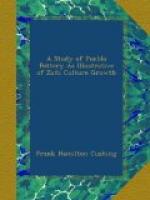[Illustration: FIG. 500.—Gourd vessel enclosed in wicker.]
POTTERY ANTICIPATED BY BASKETRY.
This crude beginning of the wicker-art in connection with water-vessels points toward the development of the wonderful water-tight basketry of the southwest, explaining, too, the resemblance of many of its typical forms to the shapes of gourd-vessels. Were we uncertain of this, we might again turn to language, which designates the impervious wicker water-receptacle of whatever outline as tom ma, an evident derivation from the restricted use of the word tom me in connection with gourd or cane vessels, since a basket of any other kind is called tsi i le.
It is readily conceivable that water-tight osiery, once known, however difficult of manufacture, would displace the general use of gourd-vessels. While the growth of the gourd was restricted to limited areas, the materials for basketry were everywhere at hand. Not only so, but basket-vessels were far stronger and more durable, hence more readily transported full of water, to any distance. By virtue of their rough surfaces, any leakage in such vessels was instantly stopped by a daubing of pitch or mineral asphaltum, coated externally with sand or coarse clay to harden it and overcome its adhesiveness.
[Illustration: FIG. 501.—Havasupai clay-lined roasting-tray.]
We may conclude, then, that so long as the Pueblo ancestry were semi-nomadic, basketry supplied the place of pottery, as it still does for the less advanced tribes of the Southwest, except in cookery. Possibly for a time basketry of this kind served in place of pottery even for cookery, as with one of the above-mentioned tribes, the Ha va su pai or Coconinos, of Cataract Canon, Arizona. These people, until recently, were cut off from the rest of the world by their almost impenetrable canon, nearly half a mile in depth at the point where they inhabit it. For example, when I visited them in 1881, they still hafted sharpened bits of iron, like celts, in wood. They had not yet forgotten how to boil food in water-tight basketry, by means of hot stones, and continued to roast seeds, crickets, and bits of meat in wicker-trays, coated inside with gritty clay. (See Fig. 501.) The method of preparing and using these roasting-trays has an important bearing on several questions to which reference will be made further on. A round basket-tray, either loosely or closely woven, is evenly coated inside with clay, into which has been kneaded a very large proportion of sand, to prevent contraction and consequent cracking from drying. This lining of clay is pressed, while still soft, into the basket as closely as possible with the hands and then allowed to dry. The tray is thus made ready for use. The seeds or other substances to be parched are placed inside of it, together with a quantity of glowing wood-coals. The operator, quickly squatting, grasps the tray at opposite edges, and, by a rapid spiral motion up and down, succeeds in keeping the coals and seeds constantly shifting places and turning over as they dance after one another around and around the tray, meanwhile blowing or puffing, the embers with every breath to keep them free from ashes and glowing at their hottest.




